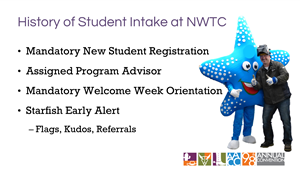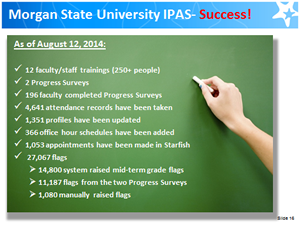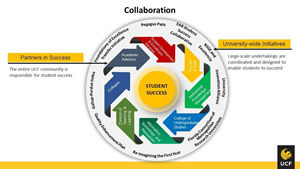The call to action “Addressing Student Success” is by no means a small or simple task. The response cannot be a short-term project with easily achievable goals a campus will be able to launch one year and then declare victory a year or two later. Institutions that have seen some success in this area report they have been doing this work for a decade or more. They do not consider the work finished; rather, they are even more committed to and excited about the work that has transformed their campuses and the lives of so many students.
For the last two years, student success has been in EDUCAUSE’s Top 10 IT issues. In fact, IT professionals identified it as number two this past year, immediately following the issue of security. Student success efforts are bringing about the implementation of new technologies, changing processes, integrating tools, and forcing institutions to rethink how they support students, centered not on the administration but on the students themselves.
The work, as EDUCAUSE staff have witnessed while supporting institutions’ efforts, entails a thoughtful implementation of technologies guided by the integral part of change management—getting people to change the way they do things. In our work with the institutions, we developed tools that offer a mix of best practices in deploying and/or choosing technologies in this area of student success, combined with a purposeful approach to the “people change” aspect that is critical for this work to succeed. These tools allow an institution to follow proven best practices and avoid common pitfalls as they prepare to select and implement the three key pillars of iPASS (Integrated Planning and Advising for Student Success), also popularly known as technology-enabled advising.
Checklists for key aspects of technology-enabled advising reform each offer a compilation of questions and items for institutions to consider as they explore technology solutions for these areas:
Checklist for Early Alert Technology
Checklist for Degree Planning Technology
Checklist for Predictive Analytics Technology
The iPASS Rollout and Adoption Guide is made up of a series of interconnected guides that support critical components of a technology implementation and adoption plan, providing best practices and tools to help an institution develop and carry out a plan for the introduction of new tools and business practices in support of student success efforts. The guide has four sections:
- Communication
- Training
- Evaluation
- Refinement and Scaling
Another useful set of resources emerging from iPASS is available in the Return on Investment Toolkit. Given the limitations on institutional dollars and the uncertainty of grants, leadership of student success programs must take a strategic approach. The iPASS grantee institutions, in their approaches to implementing technology-enabled advising, were all asked to consider how the money invested in this work could pay off for the bottom line using a version of this tool. It allows an institution to expand its thinking beyond budgeting: Will putting new financial resources into technology purchases, staff salaries, new hires, professional development, consultants, or other areas ultimately result in more students staying at the institution longer and completing their programs? The spreadsheet-style tool allows specific calculations to answer this question over time.
The guide, the checklists, and the toolkit are all instruments that have been used by pioneering institutions and are now available to inform the work of higher education institutions looking to travel this road to improved student success. But they are not in and of themselves enough to guarantee that an institution will reach its goals. There are no silver bullets or one-size-fits-all solutions. Rather, as noted in the first article in this series, institutions need to bear several key principles in mind and attend to them regularly throughout the life of the initiative and beyond.
The elements that we learned and shared in our first article in this series represent best practices to organizing and sustaining an institution’s student success effort:
- Cross-functional teams are a must. While the specific makeup of the team will vary according to the needs of an institution, our recommendation to the grantees was for a core team of no more than eight individuals representing the key areas working on or impacted by the technology-enabled advising reform. These roles should be on the team:
- Project Leader: sees the full picture of the work, both the vision and goals and also the detail that is required for effective internal communications.
- Communications Expert: has a deep knowledge of the institution’s student success work and is heavily involved in or leading the communication of that work.
- Information Technology (IT) Director or his/her representative: able to help the team communicate the benefits of the new technologies and aid those responsible for training by giving them a sense of areas where new users will need help.
- Administrator Responsible for Advising: knows the current advising and planning processes and policies and how the technology-enabled reforms will impact these.
- Advisor(s): can help explain exactly how the reforms will affect advisors and students, giving the rest of the team a stronger grip on those core audiences.
- Faculty: can represent the perspective of a core stakeholder group that is being asked to alter their behaviors or processes.
- Institutional Research Representative: can help to evaluate the progress toward technology-assisted advising reform goals.
- Student(s): will help to ensure the buy-in essential to successful adoption of the new technology and processes and will assist the team’s planning for communications and training.
- Leadership is key. The institutions that have been most successful in working toward their vision have identified, named, and charged a leader for their student success transformation. Leadership at all levels is important, and having direct access to and real support from the institution’s president provides the strongest possible backing for a reform effort. We have witnessed new titles emerging for those charged to lead this work: Vice President of Student Success, Vice Provost for Student Success, Dean of Retention and Completion, Assistant Vice President of Student Success. Involved and participatory leadership is key: The buck should stop in one place so that the institution knows who is leading and where to go to get support. At institutions that have been especially strong in this area, top leadership includes the message of student success in their own messaging. For instance, see this newsletter from Middle Tennessee State University President Sidney McPhee, which places technology-enabled student success reforms clearly in the context of the institution’s vision. Dr. McPhee’s newsletter always has an update and a callout to the student success work, keeping it at the forefront.
- Set a vision and communicate it often, and in multiple ways. Communicating WHY in order to build buy-in is critical, as is communicating HOW in order to get stakeholders to understand the ways in which parts of the work tie together. Often there are so many developments happening under the label “student success” that those involved experience the phenomenon known as initiative fatigue. In this graphic representation, the University of Central Florida connected their initiatives under a broader vision of student success:
- Measure often and refine based on what is learned. The most successful institutions collected their metrics, analyzed their results, and “wondered why:” that is, they did not seek to blame any lack of success on particular individuals, but refined the processes to continue the work. Here are some of the practices we recommend for measurement and analysis:
- First, measure adoption. It is important to determine, early on, that the targeted users are actually adopting the new technology, new processes, and new procedures. Only then will it be possible to measure results.
- Measure early results. For instance, are students making appointments with their advisors more often after a campaign encouraging them to do so?
- Of course institutions are seeking positive changes in major metrics such as persistence, retention, and graduation. To see these top-level indicators move in the right direction, the team will need to analyze early results and refine the processes or areas that could be affecting them.
- We recommend consulting the “Refinement and Scaling” section of the Rollout and Adoption Guide described earlier for tools to support these efforts.
- Celebrate! For a key effort such as improving student success, it is important to maintain momentum over the long haul. One important part of doing so is by hailing milestones as they occur, giving positive reinforcement to everyone involved. We’ve seen several institutions use celebration to generate further enthusiasm for their reform:
- University of Texas at San Antonio: UTSA maintains and regularly updates a web page containing slide decks, images, and videos of all their events over several years that are related to technology-enabled advising reform.
- Northeast Wisconsin Technical College: NWTC uses a mascot representing an early alert software product, Starfish, to build buy-in. The mascot visits with faculty that are participating in the Early Alert, celebrating their results and spreading the energy across campus.

- Morgan State University: During their initial implementation of a student success system, MSU offered a public report to faculty on how far they had come with training and initial usage of the early alert system Starfish. The report included this representation of their success:

Using information like this to communicate results widely to key stakeholders in the institution helps to build appreciation for the positive changes going on.
- A bungled FAFSA rollout threatens students’ college ambitions - April 19, 2024
- Using real-world tools to prepare students for the workforce - April 18, 2024
- 8 top trends in higher education to watch in 2024 - April 16, 2024


